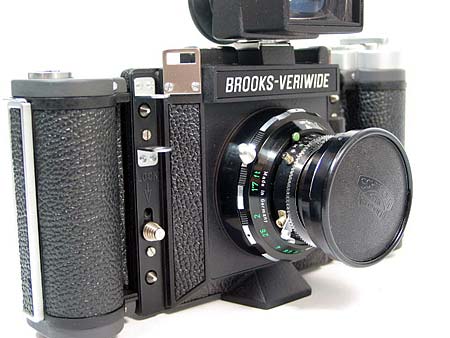Home Search Gallery How-To Books Links Workshops About Contact
|
© 2005 KenRockwell.com INTRODUCTION This is a kludge of a medium format panoramic camera. It is a fixed Schneider 47mm f/8 lens attached to a clumsy Mamiya 6 x 9 cm back. It gives about the same angle of view as a 20mm lens on a 35mm camera. It was built from about 1965 till around 1975. Newer models like the one pictured have an f/5.6 lens. I had an older f/8 model. It gives eight 55 x 79mm images on 120 film or 16 on 220 film. A newer version uses the 47mm f/5.6 Super Angulon and the newest Proshift version even added lens shifts. An older version called the Brooks-Plaubel Veriwide 100 was a far more elegant solution. Today I prefer my Mamiya 7 with 43mm lens. SPECIFICATIONS Film: It puts eight skimpy 55 x 79mm images on common 120 medium- format film or 16 on 220 film. Lens: 47mm f/8 Schneider Super Angulon lens, 6 elements in 4 groups. 40.5mm filter thread. Buy a step-up ring to allow use with normal filters. Five-bladed diaphragm stops from f/8 to f/32 with clicks at each full stop. Of course you may set it to any aperture. OR 47 mm f/5.6 Super Angulon Lens f/5.6 - f/32. 1 - 1/500 + B Compur Shutter. X (normal) and M (flashbulb) flash sync. V selftimer position. More data at Schneider Optics and here. Shutter: 1 - 1/500 second plus bulb. X Flash sync to 1/500 second. Focus: One guesses the distance and sets it on a scale calibrated from about 2.3 feet to infinity, just like the Hasselblad SWC. There is no rangefinder and there is no ground glass. You focus by guessing, taping or measuring the distance with a separate external rangefinder. These external accessory rangefinders were common photo accessories before the 1960s when very few cameras had built-in rangefinders. There also are odd arbitrary metric conversions exactly at each foot marking, which is weird considering the camera and lens were made in Germany. Honestly, I just guessed and got great sharp results every time. Remember the lens is only an f/8, so the depth of field is generous even wide open. Composition is with a Mamiya viewfinder attached to the top. Users Manual here. PERFORMANCE This is all of course limited by the lens. It's great: it's very sharp at every aperture, there is no distortion and there are no ghosts. The biggest gotcha is your ability to guess or tape focus distances and whether or not your camera hasn't been dropped in 40 years and is still aligned properly. To test this make some photos of a far away ridge of trees diagonally across the image at f/8. The entire image ought to be sharp. If one or both sides are less sharp than you've got a problem. It has a very quiet shutter and very smooth shutter release. This makes it great for long hand-held exposures. The lens has lots of light fall-off at all apertures. This is normal for a view-camera lens. I got consistently great results hand held. I returned the camera I had to the used dealer from whom I bought it because the filter thread was so badly dinged I could not attach any filters, which are important to me. RECOMMENDATIONS This is a 30 year old camera. Be sure to buy one you can inspect in person, NOT over eBay. Get a filter step up ring to use common filters effectively. I use a 40.5mm to 52mm ring and then a 52mm to 67mm ring to allow me to use my 67mm filters with no vignetting. I'm unsure if 52mm or 40.5mm filters alone are OK. (40.5mm filters were common in 1959 and are still popular today in the motion picture industry for use behind cine lenses.) You have to wind the film with the wind knob AND cock the shutter for each shot separately. There is no double-exposure prevention. You are in luck for film filing: you easily can fit two of the 79mm wide images in a standard file page cut for three frames of 6 x 6 cm. Therefore these images are very easy to file and proof one one sheet, much easier actually than the far more common 6 x 7 cm format You're in luck for scanning: all medium format scanners like the Minolta Multi PRO go up to 6 x 9cm (really 55 x 84 mm) and will cover this entire image. Other panoramic cameras like the Veriwide 100 and Noblex give images too wide to fit in most scanners. See also my Linhof 617 page. See how to scan these weird sizes here. |

